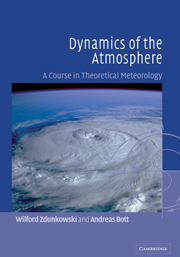Book contents
- Frontmatter
- Contents
- Preface
- Part 1 Mathematical tools
- Part 2 Dynamics of the atmosphere
- 1 The laws of atmospheric motion
- 2 Scale analysis
- 3 The material and the local description of flow
- 4 Atmospheric flow fields
- 5 The Navier–Stokes stress tensor
- 6 The Helmholtz theorem
- 7 Kinematics of two-dimensional flow
- 8 Natural coordinates
- 9 Boundary surfaces and boundary conditions
- 10 Circulation and vorticity theorems
- 11 Turbulent systems
- 12 An excursion into spectral turbulence theory
- 13 The atmospheric boundary layer
- 14 Wave motion in the atmosphere
- 15 The barotropic model
- 16 Rossby waves
- 17 Inertial and dynamic stability
- 18 The equation of motion in general coordinate systems
- 19 The geographical coordinate system
- 20 The stereographic coordinate system
- 21 Orography-following coordinate systems
- 22 The stereographic system with a generalized vertical coordinate
- 23 A quasi-geostrophic baroclinic model
- 24 A two-level prognostic model, baroclinic instability
- 25 An excursion concerning numerical procedures
- 26 Modeling of atmospheric flow by spectral techniques
- 27 Predictability
- Answers to Problems
- List of frequently used symbols
- References and bibliography
- Index
18 - The equation of motion in general coordinate systems
Published online by Cambridge University Press: 05 June 2012
- Frontmatter
- Contents
- Preface
- Part 1 Mathematical tools
- Part 2 Dynamics of the atmosphere
- 1 The laws of atmospheric motion
- 2 Scale analysis
- 3 The material and the local description of flow
- 4 Atmospheric flow fields
- 5 The Navier–Stokes stress tensor
- 6 The Helmholtz theorem
- 7 Kinematics of two-dimensional flow
- 8 Natural coordinates
- 9 Boundary surfaces and boundary conditions
- 10 Circulation and vorticity theorems
- 11 Turbulent systems
- 12 An excursion into spectral turbulence theory
- 13 The atmospheric boundary layer
- 14 Wave motion in the atmosphere
- 15 The barotropic model
- 16 Rossby waves
- 17 Inertial and dynamic stability
- 18 The equation of motion in general coordinate systems
- 19 The geographical coordinate system
- 20 The stereographic coordinate system
- 21 Orography-following coordinate systems
- 22 The stereographic system with a generalized vertical coordinate
- 23 A quasi-geostrophic baroclinic model
- 24 A two-level prognostic model, baroclinic instability
- 25 An excursion concerning numerical procedures
- 26 Modeling of atmospheric flow by spectral techniques
- 27 Predictability
- Answers to Problems
- List of frequently used symbols
- References and bibliography
- Index
Summary
Introduction
The numerical investigation of specific meteorological problems requires the selection of a suitable coordinate system. In many cases the best choice is quite obvious. Attempts to use the same coordinate system for entirely different geometries usually introduce additional mathematical complexities, which should be avoided. For example, it is immediately apparent that the rectangular Cartesian system is not well suited for the treatment of problems with spherical symmetry. The inspection of the metric fundamental quantities gij or gij and their derivatives helps to decide which coordinate system is best suited for the solution of a particular problem. The study of the motion over irregular terrain may require a terrain-following coordinate system. However, it is not clear from the beginning whether the motion is best described in terms of covariant or contravariant measure numbers. We will discuss this situation later.
From the thermo-hydrodynamic system of equations consisting of the dynamic equations, the continuity equation, the heat equation, and the equation of state we will direct our attention mostly toward the equation of motion using covariant and contravariant measure numbers. We will also briefly derive the continuity equation in general coordinates. In addition we will derive the equation of motion using physical measure numbers and assuming that the curvilinear coordinate lines are orthogonal.
The starting point of the analysis is the equation of motion in the absolute coordinate system. The description of the motion in a rotating and time-dependent coordinate system, in general, requires knowledge of the rotational velocity of a point in the atmosphere as well as the deformation velocity of the material surface on which the point is located.
- Type
- Chapter
- Information
- Dynamics of the AtmosphereA Course in Theoretical Meteorology, pp. 513 - 531Publisher: Cambridge University PressPrint publication year: 2003



